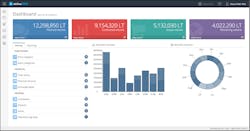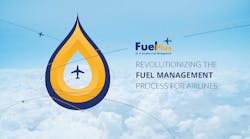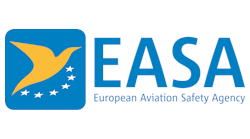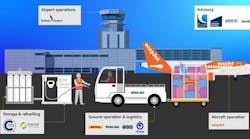Because fuel is a major expense in the aviation world, officials with the FuelPlus Group say it is in an airline's best interest to seek an efficient, streamlined fueling process to keep related costs as minimal as possible.
Klaus-Peter Warnke, CEO at FuelPlus, explains that saving 2 to 3 percent on fuel costs can be equivalent to selling hundreds of thousands of passenger tickets when looking at an airline’s annual bottom line.
As a result, FuelPlus has taken a larger view on the entire aviation fuel management process, looking for ways to help its customer’s reduce operating costs.
“Fuel is something that is an enterprise-wide process for suppliers. When we look into the airlines, we have different activities around fuel,” Warnke says.
These activities include preparation processes, including both volume planning and budget planning. Then there are several tender activities to ensure that the fuel required for different locations is available. That leads to supply contracts, which are managed by supply chain operations, in order to deliver fuel product from refineries to the airports.
Later on, there are activities around operations, such as collecting fuel tickets and documentation of delivery of fuel into storage systems.
What’s more, airlines then need to handle accounting processes, such as calculating expected costs for the month, as well as checking and receiving invoices.
“Quite often, we see this organized in a way which is more based on silos – the planning department, the procurement department, an operations team and an accounting team working independent of each other, using their own products, using their own tools,” Warnke says. “That, obviously, leads to a lot of inefficiencies in managing fuel in a professional way.”
To improve workflow, FuelPlus provides its airline.ONE software, which has been implemented by more than 50 airlines. Among other features, the solution reduces fuel usage; cuts manual administration; increases internal efficiencies; and complies with audit and reporting guidelines.
“Aviation fueling is a quite complex process, which needs all the different companies, all the different entities, to work together to make it happen,” Warnke says. “Our vision at FuelPlus is to automate, and to bring efficiencies to this process.”
The CEO of FuelPlus points to automation as the most important feature of airline.ONE because of the productivity it can lend to staff during day-to-day operations.
“You want your people to become more efficient. You want to use their knowledge and release them for all the daily routine activities,” he says. “You want to use the knowledge of your people to do analysis, to look for new ways to provide fuel to the airline or find new processes that can save money.”
Warnke also notes that staying compliant with various regulations is vital, and is something airline.ONE provides.
“You want to make sure that all the different processes around tendering, contract management, accounting, invoice checking and payment are done to accounting standards and according to audit requirements,” he says, adding the appropriate software ensures checks and balances and implements controls.
airline.ONE is offered as software as a service (SaaS), which reduces the amount of setup required for customers. It can be hosted in the Cloud or in a FuelPlus data center. Further flexibility is provided by allowing customers to subscribe to standalone modules to automate specific processes.
The amount of training required to use the platform varies depending on the background of the individuals utilizing it.
“If you talk to people who are knowledgeable in the underlying fuel management processes, then it’s basically a plug-in. So we would be offering a tool that basically fits into the existing processes,” Warnke says. “If you’re talking to people who are new to the industry, then obviously it’s quite a bit more training to raise awareness and to understand the principles of fuel management.”
Updates have been built in regularly throughout the 20 years the software platform has existed.
“We’ve implemented a lot of best practices into the product,” Warnke explains, noting these upgrades were created based on customer feedback.
In addition to airline.ONE, the company offers a supplier product, supplier.ONE and is at the forefront of facilitating data exchange across its portfolio to help airlines and fuel suppliers automate fuel management information.
“If you look into aviation fuel, then you also have to look across boundaries,” Warnke states. “In the end, it’s something in which airlines and suppliers and also into-plane companies that are in charge of fueling the aircraft need to collaborate.”
Initially involved in the development of fuel management products for Lufthansa, FuelPlus has been in the field for more than 20 years – primarily in Europe and Asia. The company has recently moved into the U.S. market, where there are differences in the way fuel is procured.
In Europe and Asia, Warnke explains, fuel management is based on an into-wing model. However, in the United States, airlines have more access to infrastructure, so they can rent tank storage.
“So they have the option to buy fuel product into the tank at the airport. This means there is a need for inventory management,” Warnke says.
“There are also opportunities in the U.S. to operate your own supply lines,” he continues, noting that involves additional logistics planning and execution. “And the tax system in the U.S. is quite complex. This is sometimes a burden to have all these taxes set up correctly in order to calculate costs and to check invoices.”
He says FuelPlus can use its expertise to handle specialized calculations, which helps with functionality and ease of implementation for the end user.
“Looking into the U.S., we see there’s a lot of room for improvement. Things are very manual,” Warnke says. “Sometime in the near future, I’m very optimistic we can bring all the airlines, the suppliers and also the into-plane companies at the airports into the mix – to connect all of them and really have automated process that will make the life of everyone involved much, much easier.”





